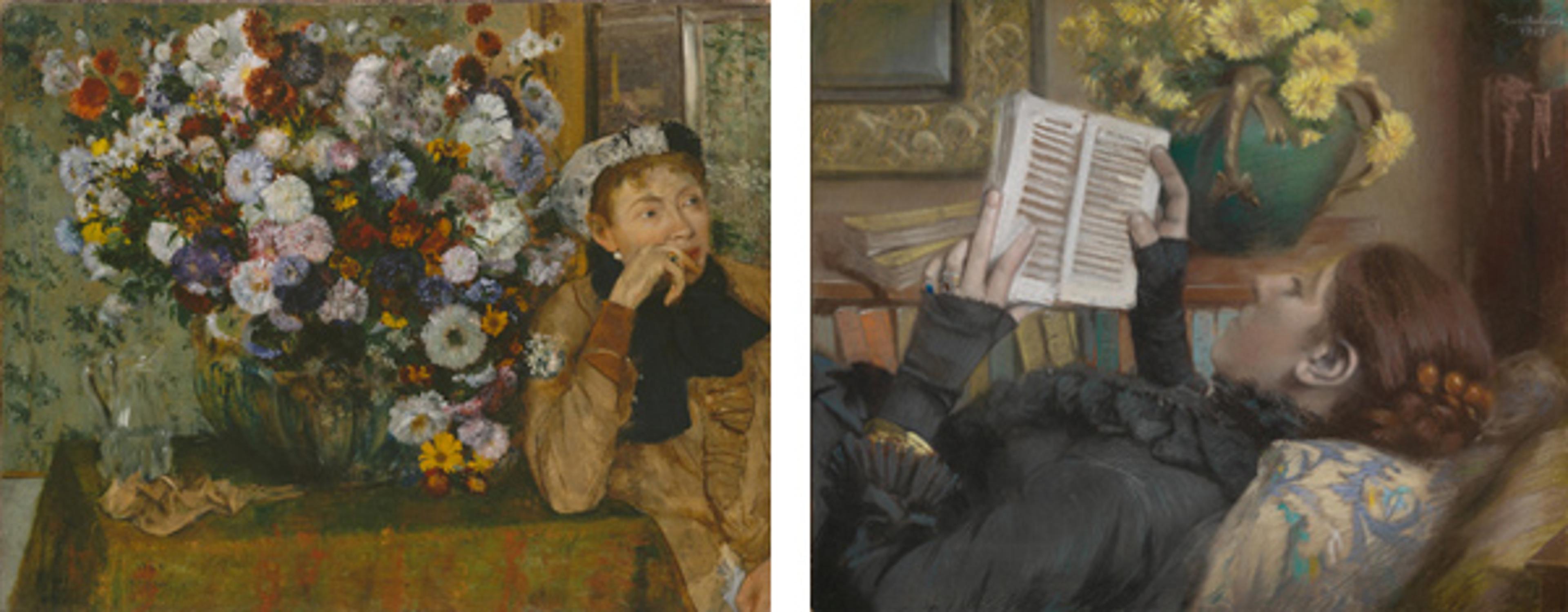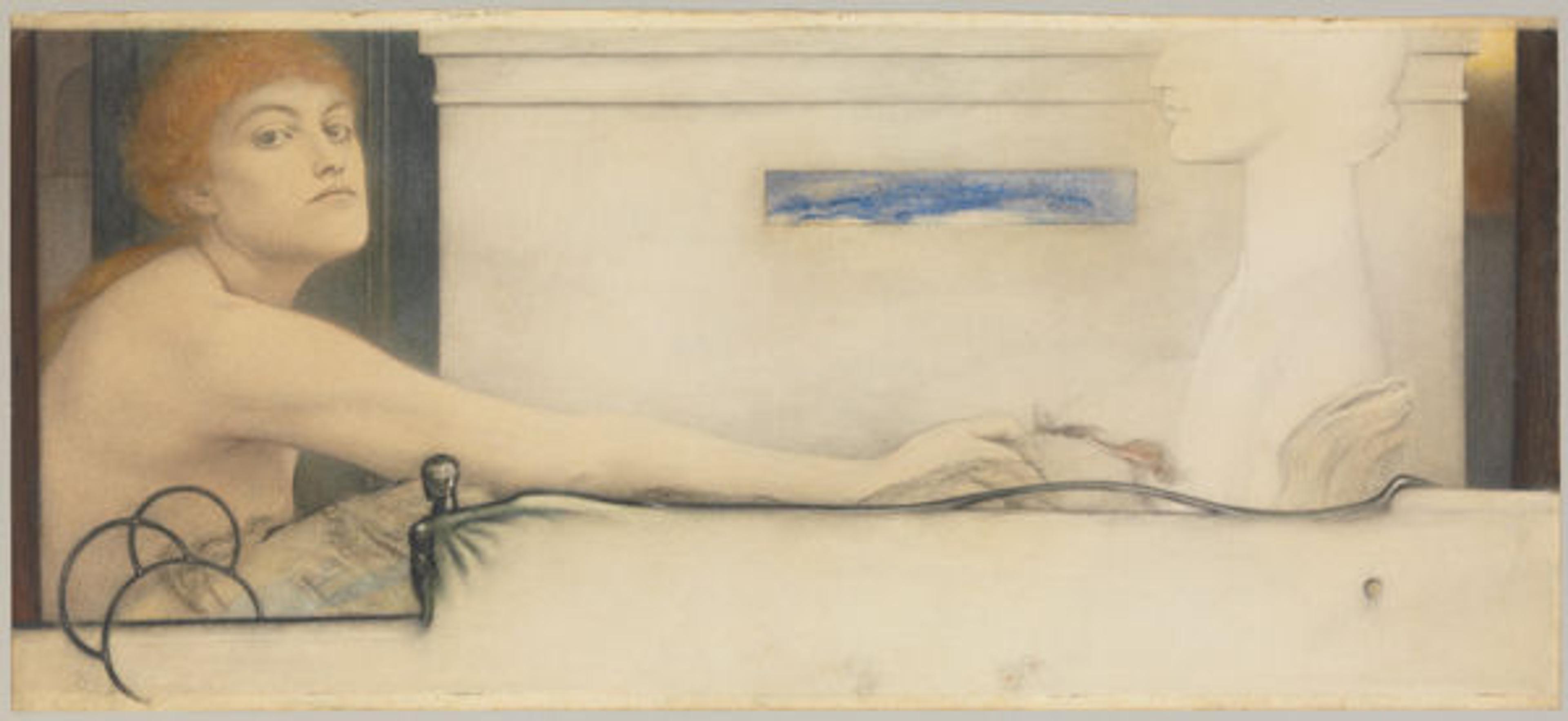Ready for a Close-Up: Fernand Khnopff's Hortensia

Fernand Khnopff (Belgian, 1858–1921). Hortensia, 1884. Oil on canvas; 18 13/16 x 23 1/2 in. (47.8 x 59.7 cm). The Metropolitan Museum of Art, New York, Purchase, Bequest of Julia W. Emmons, by exchange, and Catharine Lorillard Wolfe Collection, Wolfe Fund, and Promised Gift of Charles Hack and the Hearn Family Trust, 2015 (2015.263)
«How does an artist go about composing a view? In the nineteenth century, convention dictated that scenes of everyday life should have a well-defined sense of space and a clear focal point, with figures—the "human interest" aspect of a picture—front and center. However, one of our new acquisitions, Hortensia, by the Belgian artist Fernand Khnopff, tackles the question of composition from a whole new angle.»
Khnopff likely set the painting in his family's country home in the Belgian countryside, perhaps asking his sister and favorite model, Marguerite, to pose for him. Instead of staging the scene in a typical way, he zooms in on a single object: a flowering hydrangea (hortensia, in French). Shown from close up, and almost at eye level, the hydrangea dominates the picture, while the figure takes a literal back seat in the far left corner. The perspective compresses the space of the room so that the table recedes sharply away from us and the walls and door are flattened out. (You can now judge the dramatic visual impact for yourself by visiting the work in gallery 813.)
To twenty-first-century eyes, Khnopff's canvas looks like a snapshot, something we might post on Instagram. In the 1880s photography was still a young medium, one that exemplified new and exciting forms of vision. Khnopff was among the first crop of artists to experiment with photographs in his work, but he probably had other inspirations for this canvas, including Japanese woodblock prints, which were very popular at the time.
The effect of an offhand view, caught in passing, is also similar to the scenes of modern life being made by Khnopff's French counterparts Edgar Degas and Gustave Caillebotte, whose work he may have seen during his time in Paris. In our galleries you can find a number of pictures in which artists take a daring approach to composition: cropping, moving in for a close-up, and manipulating depth and perspective. Two of the finest examples on view in the Met's collection are by Edgar Degas and his friend Albert Bartholomé (below).

Left: Edgar Degas (French, 1834–1917). A Woman Seated beside a Vase of Flowers (Madame Paul Valpinçon?), 1865. Oil on canvas; 29 x 36 1/2 in. (73.7 x 92.7 cm). The Metropolitan Museum of Art, New York, H. O. Havemeyer Collection, Bequest of Mrs. H. O. Havemeyer, 1929 (29.100.128). Right: Albert Bartholomé (French, 1848–1928). The Artist's Wife (Périe, 1849–1887) Reading, 1883. Pastel and charcoal on wove paper, laid down on blue wove paper, laid down on stretched canvas; 19 7/8 x 24 1/8 in. (50.5 x 61.3 cm). The Metropolitan Museum of Art, New York, Catharine Lorillard Wolfe Collection, Wolfe Fund, 1990 (1990.117)
Khnopff went on to become famous for a very different type of art: haunting portraits and mystical portrayals of women, of which the Met owns a beautiful example, The Offering. Even Hortensia, which depicts an everyday moment, has an atmosphere of serenity and suggestiveness that anticipates the mature work of Khnopff and other Northern European Symbolists such as Vilhelm Hammershøi. These quietly magical paintings are some of my favorite works in our collection.

Fernand Khnopff (Belgian, 1858–1921). The Offering, 1891. Pastel, graphite, and chalk on paper; 13 3/4 x 29 1/2 in. (34.9 x 74.9 cm). The Metropolitan Museum of Art, New York, Bequest of William S. Lieberman, 2005 (2007.49.651)
Related Links
Now at the Met: "New Arrivals in the European Paintings Galleries" (July 1, 2015)
Now at the Met: "Caillebotte's Chrysanthemums; or, Unexpected Encounters with Impressionist Interior Design" (August 12, 2015)
Alison Hokanson
Alison Hokanson is an assistant curator in the Department of European Paintings at The Met.